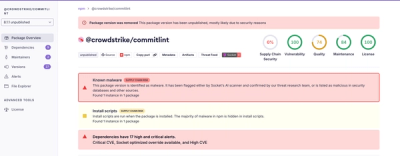
Research
Malicious fezbox npm Package Steals Browser Passwords from Cookies via Innovative QR Code Steganographic Technique
A malicious package uses a QR code as steganography in an innovative technique.
Turn your Python functions into interactive web applications. Fast Dash is an innovative way to build and deploy your Python code as interactive apps with minimal changes to your original code.
Open source, Python-based tool to build prototypes lightning fast ⚡
pip install fast-dashFast Dash is a Python module that makes the development of web applications fast and easy. It can build web interfaces for Machine Learning models or to showcase any proof of concept without the hassle of developing UI from scratch.

With Fast Dash's decorator @fastdash, it's a breeze to deploy any Python function as a web app. Here's how to use it to write your first Fast Dash app:
from fast_dash import fastdash
@fastdash
def text_to_text_function(input_text):
return input_text
# * Running on http://127.0.0.1:8080/ (Press CTRL+C to quit)
And just like that, we have a completely functional interactive app!

Fast Dash can read all the function details, like its name, input and output types, docstring, and uses this information to infer which components to use.
For example, here's how to deploy an app that takes a string and an integer as inputs and returns some text.
from fast_dash import fastdash
@fastdash
def display_selected_text_and_number(text: str, number: int) -> str:
"Simply display the selected text and number"
processed_text = f'Selected text is {text} and the number is {number}.'
return processed_text
# * Running on http://127.0.0.1:8080/ (Press CTRL+C to quit)
Output:

And with just a few more lines, we can add a title icon, subheader and other social branding details.
Output components can be arranged using a mosaic layout (ASCII art), inspired from Matplotlib's subplot_mosaic feature.
from fast_dash import fastdash, UploadImage, Graph
import matplotlib.pyplot as plt
mosaic = """
AB
AC
"""
@fastdash(mosaic=mosaic, theme="BOOTSTRAP")
def multiple_output_components(start_date: datetime.date, # Adds a date component
upload_image: UploadImage, # Adds an upload component
fips: str = [List of FIPs]) # Adds a single select dropdown
-> (Graph, plt.Figure, plt.Figure):
# Output components are a Plotly graph, and two figure components
"Fast Dash allows using mosaic arrays to arrange output components"
choropleth_map = ...
histogram = ...
radar_chart = ...
return chloropleth_map, histogram, radar_chart
# * Running on http://127.0.0.1:8080/ (Press CTRL+C to quit)

In just a few lines of code, you can also add a chat component.

You can use your favorite Python libraries. Here's an example of an advanced geospatial application built using geemap and Google Earth Engine.

Read different ways to build Fast Dash apps and additional details by navigating to the project documentation.
Duild and deploy a web app by adding a decorator only.
Fast Dash is built using Plotly Dash and it's completely open-source.
FAQs
Turn your Python functions into interactive web applications. Fast Dash is an innovative way to build and deploy your Python code as interactive apps with minimal changes to your original code.
We found that fast-dash demonstrated a healthy version release cadence and project activity because the last version was released less than a year ago. It has 1 open source maintainer collaborating on the project.
Did you know?

Socket for GitHub automatically highlights issues in each pull request and monitors the health of all your open source dependencies. Discover the contents of your packages and block harmful activity before you install or update your dependencies.

Research
A malicious package uses a QR code as steganography in an innovative technique.

Research
/Security News
Socket identified 80 fake candidates targeting engineering roles, including suspected North Korean operators, exposing the new reality of hiring as a security function.

Application Security
/Research
/Security News
Socket detected multiple compromised CrowdStrike npm packages, continuing the "Shai-Hulud" supply chain attack that has now impacted nearly 500 packages.